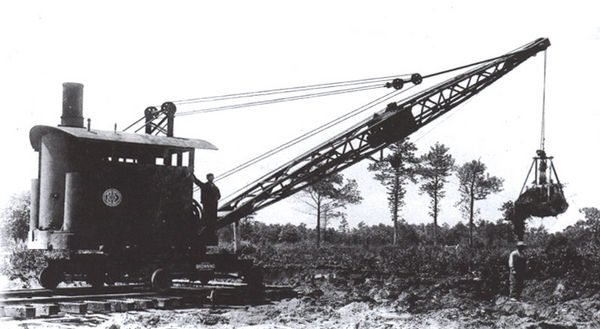The park is open daily from 9am to 7pm.
The land use history of Birch Grove Park began in 1847. In this year Hubert Somers bought 300 acres of land in Northfield. The purchase of this land marked the start of the Somers Brick Yard which began manufacturing brick in 1900. This land was suitable for brick making due to the high quality and huge quantities of clay and sand materials found there. Clay deposits make excellent brick material because it is impervious to water.
The Autobric Machine

The twenty-one ponds which exist at the park today were hand dug by workers in order to excavate clay to produce an average of 80,000 bricks per day. Eleven kilns were used in making ‘New Jersey Red Colonials,’ a soft-mud brick in a variety of shades and tint.
Clamshell Bucket Shovel

During the depression (1929 to late thirties or early forties) the plant closed and the city took over the 300-acre property for back taxes in 1951. During that period of dormancy, it became an area of classical woodland beauty as springs and rain filled the the basins of the excavated clay pits to form 21 ponds; and trees, flowers and other flora reforested the once cleared tracts.
To get credit for this earthcache:
1. What color is the clay at this location?
2. What are the overall length and width dimensions of this deposit?
3. There is an unusual object here. How long do you think it will take for erosion to cause this to fall?
4. Optional - Post a picture of a member of your team or your GPSr in front of the unusual object here.
Email your answers to #1-3 to get credit for this cache.
It was not long afterward that Engelbert ‘Inky’ Breunig – a member of the Northfield Recreation Commission – began to envision the ‘brickyard’ as a park. He worked tirelessly along with other citizens who gave their time and money in a true community effort to make that dream a reality. During the latter part of the 1950s, the City of Northfield slowly funneled money into the construction of bridges and trails at Birch Grove Park. In 1959, John Warner was given the responsibility of rangering the park.
The Birch Grove Park association was incorporated on March 28, 1952, for the purpose of developing, maintaining and improving the park. Today, the Birch Grove Park Advisory board, established in 1978 under the auspices of the Department of Parks and Recreation Committee, oversees a park that has hiking trails, recreational playing fields, a full-service campground, picnic areas, a nature center, bocce courts, the Northfield Garden Club, and the Northfield Museum and Casto house.
Most original information sourced from City of Northfield or Birch Grove Park websites.